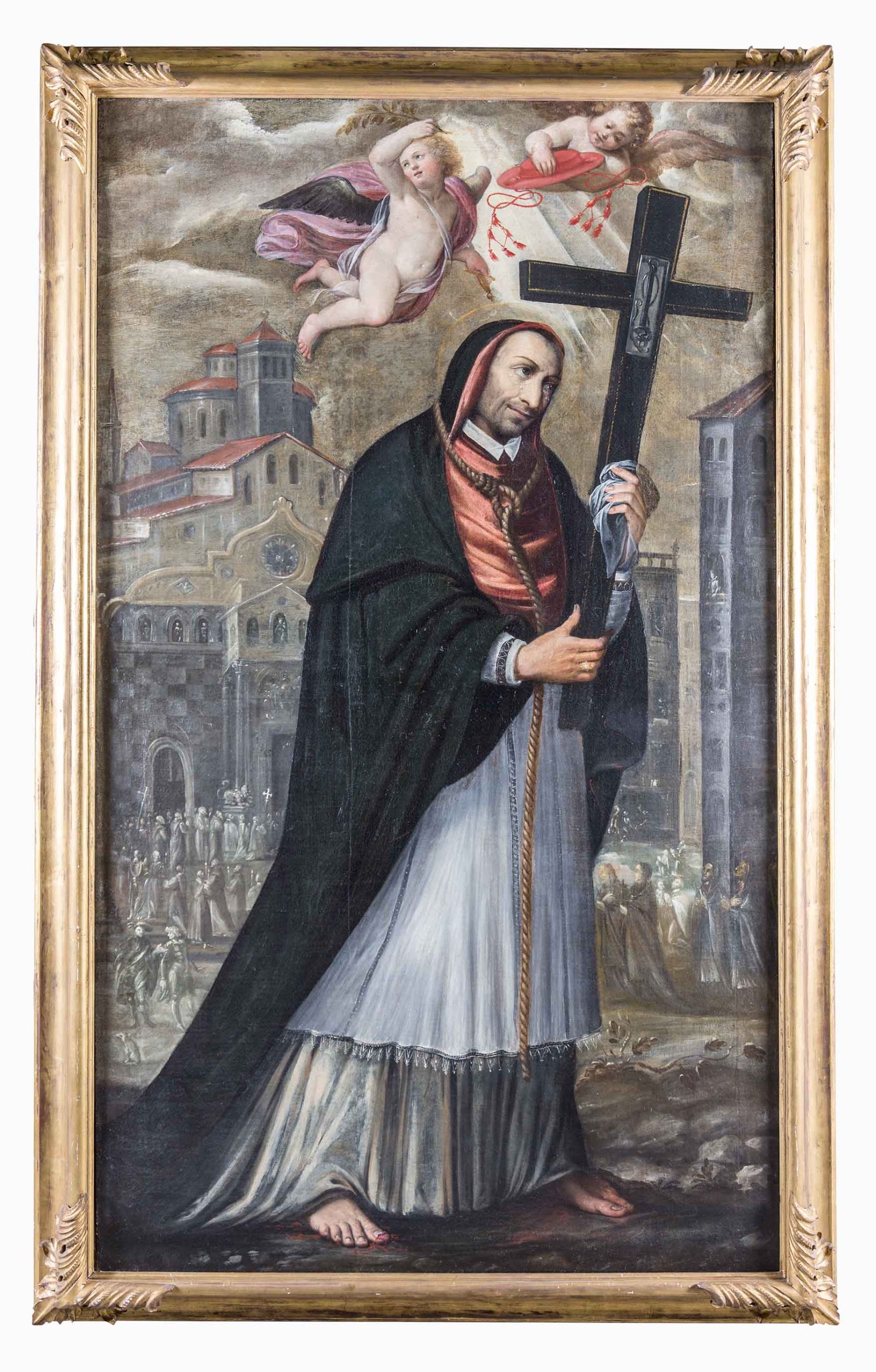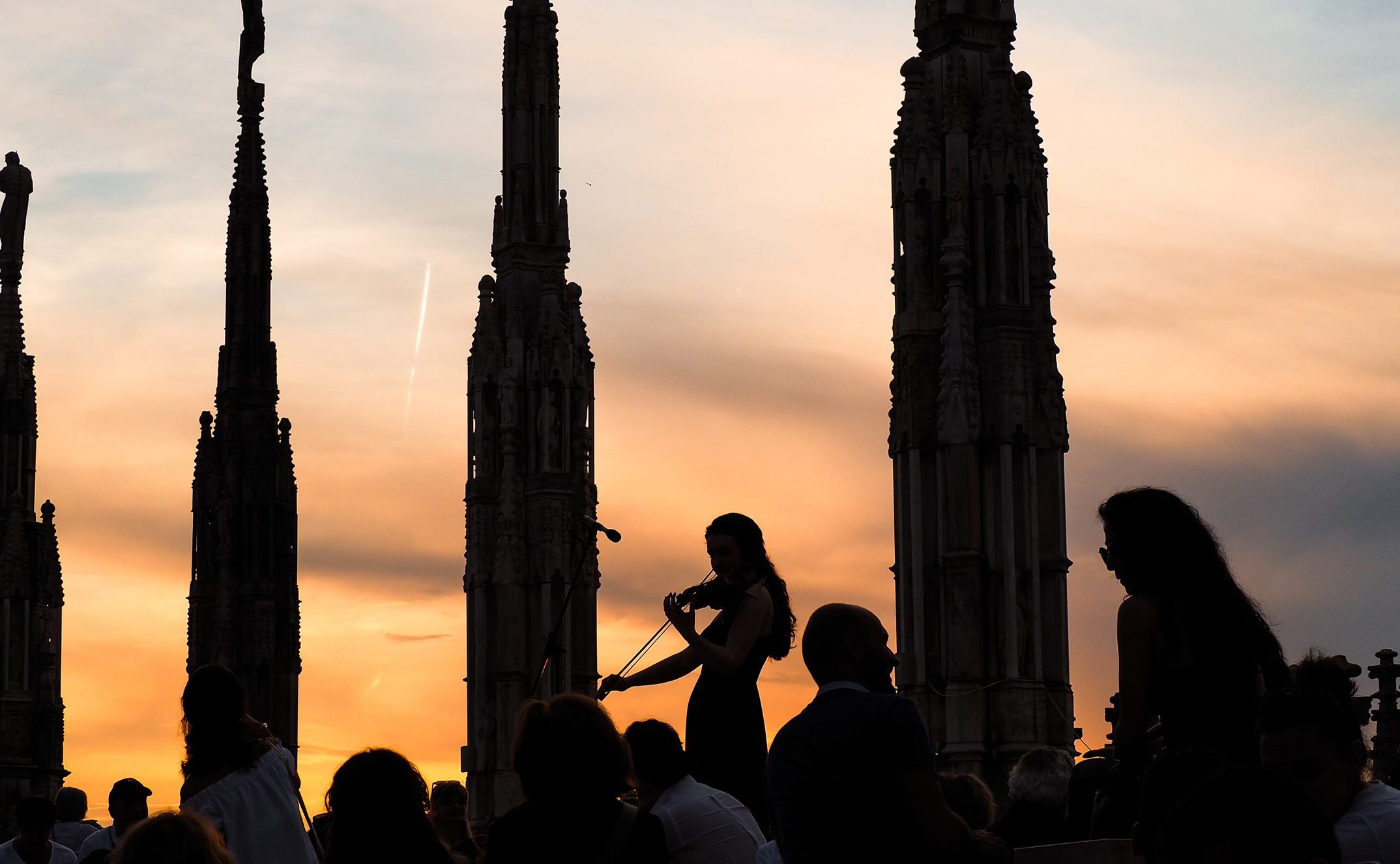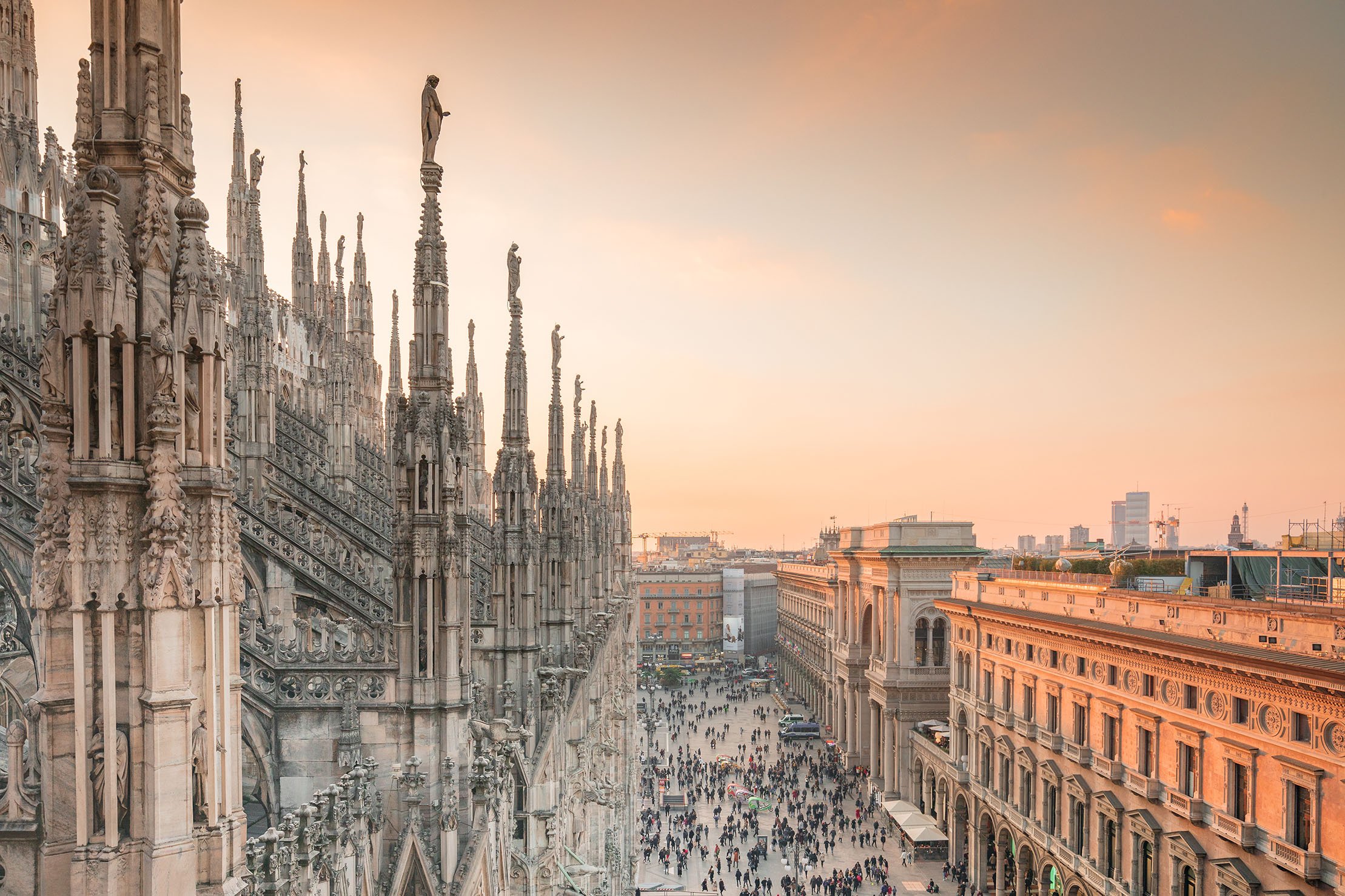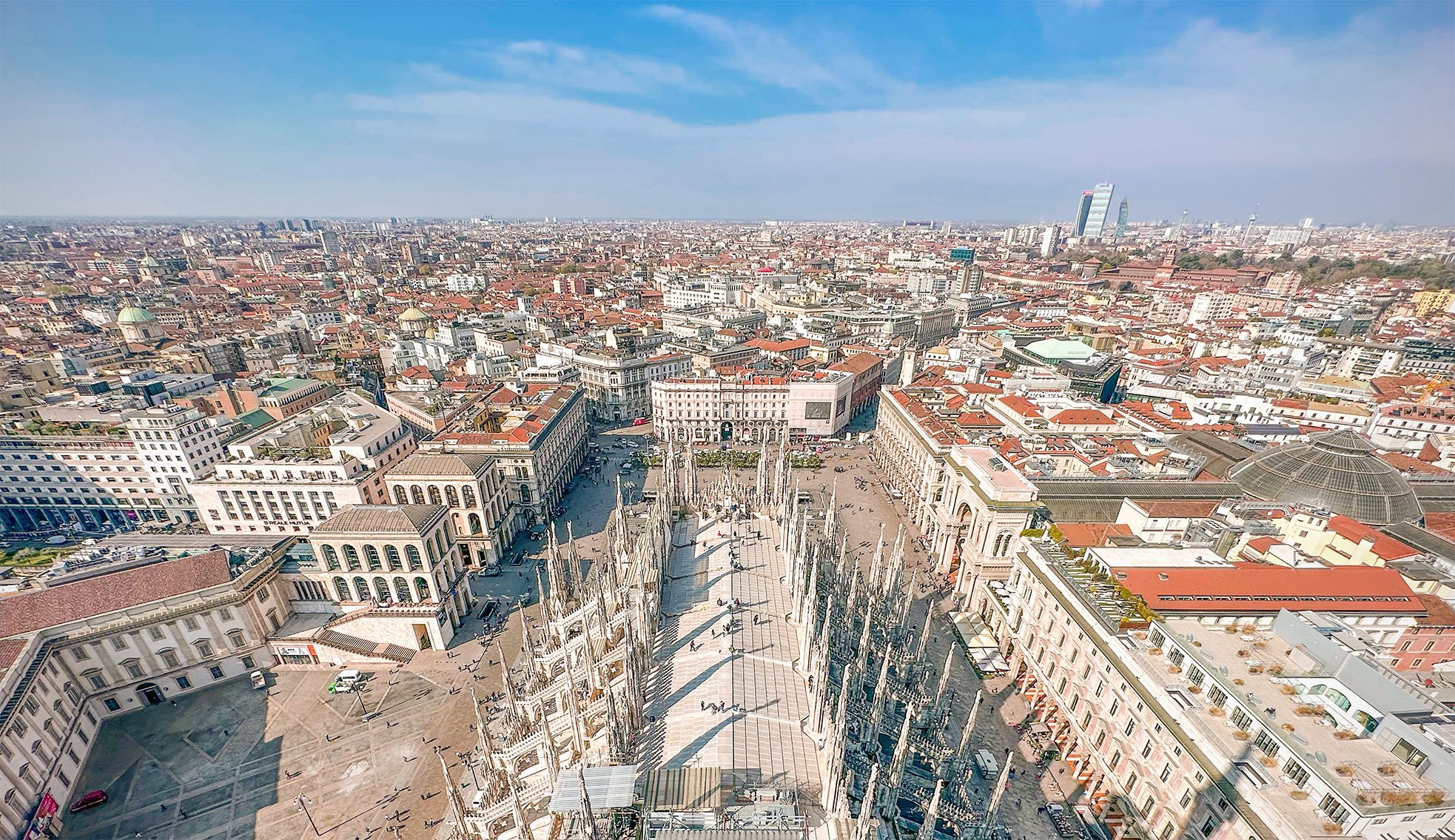DescriVedendo Museo del Duomo
CLICCA SULLA BANDIERINA PER ASCOLTARE L’AUDIODESCRIZIONE DELL’OPERA
“San Carlo in processione con il Santo Chiodo”
di Fede Galizia
“San Carlo in processione con il Santo Chiodo” è il titolo di quest’opera realizzata dalla pittrice lombarda Fede Galizia nel secondo decennio delSeicento.
Si tratta di un dipinto di dimensioni notevoli: misura infatti 216 centimetri di altezza per 121 centimetri di larghezza e si presenta quindi come un rettangolo con il lato più lungo posto in verticale.
La tecnica utilizzata è quella dell’olio su tela e il dipinto è stato realizzato con stile realistico, cercando cioè di riprodurre forme e colori come sono normalmente percepiti dall’occhio umano.
Il soggetto del dipinto è l’arcivescovo di Milano Carlo Borromeo, che tiene tra le mani una croce a guida di quella che sappiamo essere stata una processione tenutasi nel 1576 nella piazza della cattedrale, per scongiurare una pestilenza che si era abbattuta sulla città.
Il punto di vista adottato rispetto al soggetto principale è ravvicinato e diagonale: l’autrice riprende Carlo Borromeo da una posizione leggermente rialzata e di tre quarti, privilegiando oltre alla parte anteriore il suo lato destro.
Ne risulta che l’arcivescovo, raffigurato in primo piano e a figura intera, occupa gran parte della tela: la sua persona parte prossima al bordo inferiore e prende in altezza circa i quattro quinti del dipinto, lasciando spazio per le figure e le architetture di contorno solo ai lati e nella parte alta della tela.
Descriviamo ora l’aspetto del personaggio principale, per passare poi agli altri elementi presenti nel dipinto.
Carlo Borromeo è ritratto come un uomo di circa quarant’anni, che regge fra le mani una grossa croce. Tiene il capo leggermente chino in avanti e piegato verso la sua spalla sinistra.
Sul viso magro con una barba appena accennata intorno alla bocca tenuta chiusa, risaltano gli occhi, grandi e tondeggianti, dai quali scendono lacrime copiose, mentre lo sguardo è diretto alla grossa croce che porta davanti a sé.
La sua espressione è commossa ma non dolente, piuttosto appare fiduciosa e fiera. Il religioso protende in avanti l’avambraccio destro per impugnare la base di essa, mentre con il sinistro arriva più in alto, appoggiando la mano su un velo trasparente, posto circa a metà del legno verticale della stessa. La Croce, di legno scuro, dove all’intersezione dei due legni è conservata la reliquia del Santo Chiodo che fu usato per la crocifissione di Gesù, parte all’altezza dell’addome di Carlo Borromeo e arriva a superare nettamente la sommità del suo capo: dovrebbe quindi essere alta all’incirca un metro.
Dagli abiti dell’arcivescovo spuntano i piedi nudi, il sinistro davanti al destro, che rivela una ferita sull’alluce, entrambi impegnati a procedere su un terreno sconnesso dove si distinguono pietre, terra e rametti di foglie.
Carlo Borromeo indossa una serie di abiti adatti all’occasione solenne. Sopra di tutti una lunga cappa nera con strascico aperta sul davanti e con un cappuccio dal risvolto rosso che arriva sulla fronte dell’uomo coprendone del tutto la capigliatura. Dall’apertura della cappa sul davanti si vedono una corta mantellina rossa, detta mozzetta, dalla quale sul collo spunta il colletto della sottostante tunica bianca a mezza gamba chiamata rocchetto e ancora sotto ad essa un abito talare anch’esso chiaro lungo fino alle caviglie. Attorno al collo l’uomo porta una corda annodata a cappio, la cui estremità pende libera in avanti, mentre sopra la testa dell’uomo si distingue la circonferenza dorata di un’aureola.
Al di sopra della figura di Carlo Borromeo, volano due angioletti alati, raffigurati come putti dai capelli biondi ricci, coperti solo in parte nella loro nudità da stoffe fluttuanti di colore viola. L’angioletto a sinistra, una delle cui ali è di colore nero, innalza sopra la testa il braccio destro reggendo in mano un rametto d’ulivo, mentre con la mano sinistra impugna una spada con la lama rivolta verso l’alto. L’angioletto a destra sorregge con le braccia davanti a sé un particolare copricapo cardinalizio di colore rosso, detto “galero”, ai lati del quale pendono alcuni cordoncini. In mezzo agli angeli, irrompe un fascio di luce, che si staglia su un cielo scuro e gonfio di nubi e ricade sull’arcivescovo, la croce e gli astanti.
Ai lati in basso della tela, alle spalle del Borromeo, sono raffigurati in secondo piano i molti partecipanti alla processione: sulla sinistra i fedeli portano crocifissi e candele, sulla destra sono probabilmente canonici, abbigliati con abiti simili a quelli indossati dall’arcivescovo che li guida.
Tutti sono resi con pennellate essenziali e man mano che lo snodo del corteo li allontana tendono ad essere meno definiti e colorati, risultando alfine quasi esseri trasparenti.
Lo sfondo della scena è occupato da una veduta urbana che rivela come doveva apparire il centro della città attraversato dalla processione.
All’estremità destra della tela si vede la struttura alta e stretta di quello che era l’antico rione cittadino noto come Rebecchino, contraddistinto da molte finestre e un tetto a spiovente di color rosso, mentre sempre sulla destra, fra il Rebecchino e la sagoma di Carlo Borromeo si intravede Palazzo Ducale.
Infine, nella fascia alta a sinistra della tela, sempre sullo sfondo, appare la cattedrale, con un aspetto molto diverso dall’attuale: non vi sono infatti guglie e pinnacoli, ma una facciata con tre portali coronata da una cornice curva, oltre la quale si innalza la struttura del tiburio, con tetti spioventi rossi e un campanile a torre quadrata.
La principale fonte di luce nel dipinto sembra essere il raggio che squarcia le nubi sopra la testa del Santo e ne illumina il volto, oltreché le figure dei fedeli poste in basso a destra della tela.
Prevalgono per lo più i toni del grigio, sui quali risaltano in primo piano i colori rosso, nero e bianco degli abiti cerimoniali di Carlo Borromeo.
La descrizione morfologica redatta e validata tra settembre e novembre 2023, certificata DescriVedendo, è stata realizzata dal Team DescriVedendo, con Associazione Nazionale Subvedenti ETS, in collaborazione con Veneranda Fabbrica del Duomo.
DescriVedendo Duomo Museum
CLICK ON THE FLAG TO LISTEN THE AUDIODESCRIPTION
“San Carlo in procession with the Holy Nail”
by Fede Galizia
“San Carlo in procession with the Holy Nail” is the title of this work, created by the Lombard artist Fede Galizia in the second decade of the seventeenth century.
This painting is a remarkable size: it is around 216 centimetres high and 121 centimetres wide and so forms a rectangle, with the vertical being the longest side.
The technique used was oil on canvas and the painting was created in a realistic style, that is, attempting to reproduce forms and colours as they are normally perceived by the human eye.
The subject of the painting is the Archbishop of Milan, Carlo Borromeo, who holds a cross in his hands to lead what we know was a procession held in 1576 in the cathedral square to ward off a plague that had struck the city.
The point of view adopted with regard to the main subject is close and diagonal: the artist captures Carlo Borromeo from a slightly raised position at three-quarter length, favouring his right side as well as the front. The result is that the Archbishop, depicted in the foreground at full length, occupies most of the canvas: his figure starts close to the lower edge and continues up to around fourth-fifths of the height of the painting, leaving space for the figures and the surrounding buildings only at the sides and in the upper part of the canvas.
I will now describe the appearance of the main character before moving on to the other elements in the painting.
Carlo Borromeo is portrayed as a man of around forty years of age who holds a large cross in his hands. His head is slightly bowed forward and tilted towards his left shoulder.
A barely visible beard is seen on the thin face around a mouth held shut. His large, round eyes from which copious tears fall stand out, while his gaze is directed at the large cross that he carries in front of him. His expression is emotional but, rather than sorrowful, he appears hopeful and proud. The clergyman extends his right forearm to grasp its base while his left reaches higher up, the hand resting on a transparent veil placed around halfway up the wooden vertical of the Cross. At the intersection of the two pieces of wood, the Relic of the Holy Nail, which was used for the crucifixion of Jesus, is preserved. The Cross, made of dark wood, starts at the level of Carlo Borromeo’s abdomen and reaches above the top of his head: it must therefore have been around a metre high.
Bare feet stick out from the Archbishop’s clothes, the left in front of the right, which displays an injured big toe, both engaged in walking on uneven ground where stones, earth and sprigs of leaves can be seen.
Carlo Borromeo wears an outfit of clothes suitable for the solemn occasion. A long black cape with a train, open at the front, has a hood with a red cuff that reaches the man’s forehead, covering his hair entirely. Through the opening of the cloak at the front, a short red cape called a mozzetta can be seen, from which the collar of a white knee-length tunic, called a rocchetto, protrudes at the neck, and beneath that, a light-coloured cassock stretches down to the ankles. Around his neck, the man wears a cord tied in a knot, the end of which hangs freely in front while, above his head, there is the golden circumference of a halo.
Two winged angels fly above the figure of Carlo Borromeo, depicted as putti with curly blond hair, their nakedness only partly covered by fluttering purple fabrics.
The angel on the left, one of whose wings is black, raises his right arm above his head holding an olive branch in his hand while, with his left hand, he grasps a sword with the blade turned upwards. The angel on the right holds a special red cardinal’s hat, known as the galero, at the sides of which hang some short cords. From among the angels, a beam of light bursts forth that stands out against a dark sky filled with clouds and falls on the Archbishop, the cross and the onlookers.
At the lower edges of the canvas, behind Borromeo, many participants in the procession are depicted in the background: on the left, the faithful bear crucifixes and candles, those on the right are probably canons, dressed in similar clothes to those worn by the Archbishop leading them. All are rendered with essential brushstrokes and, as the procession gradually moves away and becomes less well-defined and the colours more muted, they become almost transparent.
The background of the scene is occupied by an urban view that shows how the centre of the city must have appeared as it was crossed by the procession.
At the right edge of the canvas, the tall, narrow structure can be seen of what used to be the ancient city district known as Rebecchino, featuring many windows and a red sloping roof while, also on the right, between Rebecchino and the outline of Carlo Borromeo, Palazzo Ducale can be glimpsed.
Finally, in the upper left band of the canvas, also in the background, the cathedral appears, looking very different from the current one: there are no spires or pinnacles but a façade with three portals crowned with a curved cornice, above which stands the structure of the lantern, with red sloping roofs and a square bell tower.
The main light source in the painting seems to be the ray that pierces the clouds above the Saint’s head and illuminates his face, as well as the figures of the faithful at the bottom right of the canvas.
Grey tones predominate, against which the red, black and white of Carlo Borromeo’s ceremonial robes stand out in the foreground.
The morphological description drawn up and validated between September and November 2023, certified by DescriVedendo, was created by Team DescriVedendo with the National Association of the Visually Impaired ETS, in collaboration with Veneranda Fabbrica del Duomo di Milano.

Tutti i diritti riservati – © Veneranda Fabbrica del Duomo di Milano




